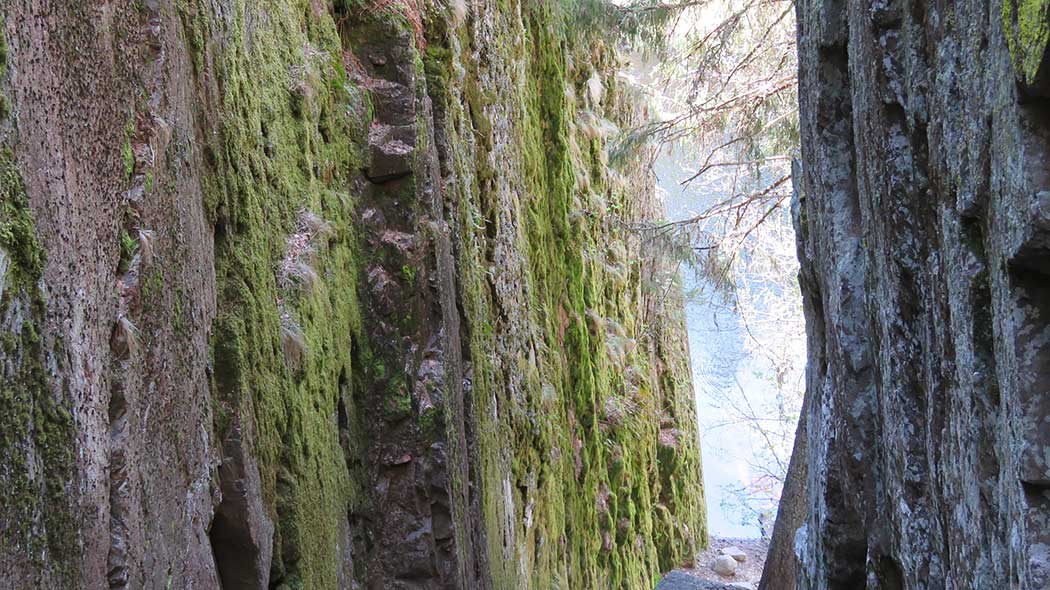Natural Features and Sights of Helvetinjärvi National Park

Helvetinkolu - the National Park’s regional emblem
The special features of the park include two rift valleys, which have been formed 150-200 million years ago by displacement of the earths crust. Helvetinkolu Gorge, located northeast of the Lake Iso Helvetinjärvi, is the most famous gorge in the area. It is narrow, only a couple of metres wide cleft, which descends steeply to the lake side.
Lakes Kovero, Luomajärvi, Iso Helvetinjärvi, Pikku Helvetinjärvi and Pitkä Helvetinjärvi form a narrow steeply sided chain in the deepest fault, north of Helvetinkolu Gorge. At their highest points the fault-line scarps reach a height of 180-210 metres above the sea level. At some places the sheer cliff faces of the lakeshores rise up to tens of metres from the lake water level.
Lake Helvetinjärvi has an abundance of different natural rock formations. You can find the best ones around ravine lakes. Along the tops of rock formations, on sheer cliffs and inside their countless nooks and crannies are unique populations of various species.
The species found along the tops of rocks and on cliffs differ from one another. Lichens and mosses, such as reindeer moss, which thrive in the sunlight, dominate the tops of rock formations. Species which thrive in the shade, such as Long-leaved fork moss, can be found on cliffs.

Predominantly on the cliffs which are shaded there is also a phenomenon of "dripping moss", which means moss grows down the side of rock walls in a slithering way. It can then detach itself from the surface in large patches. Types of moss which may grow this way are feather moss, dicranum and spaghnum moss. The most common moss in cliff crevices is the deliciously named Apple Moss.
Forests in their natural state
In the National Park there are still parts of the old backwoods in their natural state. Gorges and small forest ponds fringed with old-growth forest have the oldest tree stand. The trunks of the area's trees are embroidered with Lungwort (Lobaria pulmonaria), which benefit from the humid microclimate of old-growth forests. The presence of lungworts is a sign that a forest in its natural state. Hanging mosses (Usnea spp.) and lichens (Bryoria spp. and Alcetoria pss.) sway in wind from tree branches and shelf fungi bulge from tree trunks.

The old-growth forest can be seen for example on the hiking trail between Helvetinkolu Gorge and Lake Luomajärvi.
Helvetinjärvi National Park is in the boundary between vegetation zones, which means that northern and southern species alike can be found in the area. The Rusty Woodsia (Woodsia ilvensis), the Maiden Hair Spleenwort (Asplenium trichomanes), the Northern Spleenwort (Asplenium septentrionale), the German Catchfly (Lychnis viscaria),the Morrison's Spurrey (Spergula morisonii) and the Wood Bluegrass represent southern species, while the Alpine Catchfly (Lychnis alpina)and the Meadow-grass (Poa glauca) are northern species which grow in the area. As the soil in the area is rugged and does not have many nutrients the dominant species are non-demanding forest and mire vegetation.

In the area surrounding the gorge the quality of the earth is somewhat better and it is in these areas that most diverse herb-rich forest vegetation is found. The Baneberry (Actaea spicata), the Meadow Horsetail (Equisetum pratense), Fragrant Bedstraw (Galium triflorum),the Green Spleenwort (Coeloglossum viride), the Glyceria lithuanica, the Common Hepatica (Hepatica nobilis), the Ostrich Fern (Matteuccia struthiopteris), the European Bird Cherry (Prunus padus),the Alpine Currant (Ribes alpinum), the Small-leaved Linden (Tilia cordata) and the European Cranberrybush (Viburnum opulus) make the area lush.
The aim of Helvetinjärvi National Park is also to conserve rare species. Numerous regionally endangered and nationally threatened moss, lichen and shelf fungi species are found in the area. Several shelf fungi species which are typical of old-growth forests have been found in the Helvetinjärvi area. Some of these species are Phellinus chrysoloma, Phellinus ferrugineofuscus, Phellinus lundellii, Phellinus viticola and Fomitopsis rosea.
The Eurasian three-toed woodpecker - our spring-time drummer
Other species living in the old-growth forest include the Siberian Flying Squirrel (Pteromys volans), Three-toed Woodpecker (Picoides tridactylus) and Red-breasted Flycatcher (Ficedula parva).

Helvetinjärvi National Park
- Established 1982
- Area 50 km²

The emblem of Helvetinjärvi National Park is Helvetinkolu Gorge.
Publications of Helvetinjärvi National Park
Publications of Helvetinjärvi National Park (julkaisut.metsa.fi)






